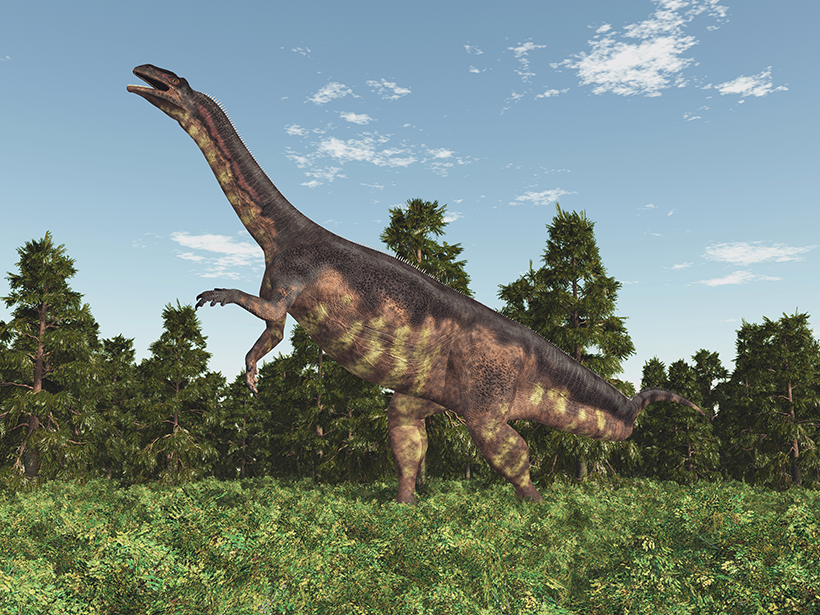There are hotbeds of dinosaur fossils around the world. However, some of the species spotted in the Southern Hemisphere don’t show up in the Northern Hemisphere until millions of years later, which makes for a paleontological mystery: Animals should have been able to make the journey northward—across the supercontinent of Pangea—in a few decades at most.
Now scientists have hypothesized that the amount of carbon dioxide (CO2) in the atmosphere might have played a role in dinosaur dispersal: Dinosaurs appeared in what is today Greenland and Germany right around the time that the planet’s atmosphere experienced a large, abrupt drop in CO2. That dip, which lasted for a few million years, likely reduced the aridity of the planet’s tropical desert belts, making the region easier to traverse, the team proposed.
Ambling Across Pangea
Roughly 230 million years ago, around the time that dinosaurs first appeared in the fossil record, Earth’s continents were crowded together to form the supercontinent of Pangea. “All the major land masses were contiguous,” said Dennis Kent, a geophysicist at Lamont-Doherty Earth Observatory of Columbia University in Palisades, N.Y.
Pangea was enormous—running more than 10,000 kilometers from north to south—but it contained no significant geographic barriers like high mountains or large seaways, said Kent. “You expect that a land animal could just walk from one place to another.”
But herbivorous dinosaur fossils appear in places like Argentina and Brazil, the erstwhile southern reaches of Pangea, millions of years earlier than they do in northern locales like Germany and Greenland. Considering that a group of dinosaurs could have easily ambled a couple of kilometers north each day, that time delay doesn’t make sense, said Kent. “You can do that in 20 years.”
Kent and Lars B. Clemmensen, a geologist at the University of Copenhagen, set out to investigate the mystery. First, they needed to accurately correlate the ages of fossils found in different regions of Pangea. The researchers focused on Plateosaurus, an herbivorous dinosaur that measured up to 8 meters from nose to tail.
A Magnetic Record
To track the passage of time over 200 million years ago, the team turned to magnetostratigraphy. This technique hinges on a well-known phenomenon: The planet’s magnetic poles reverse polarity approximately every few hundred thousand years.
Cutting into Earth’s stratigraphic layers can reveal a record of these geomagnetic reversals. That’s because certain minerals—for example, hematite—record the polarity of Earth’s magnetic field. By tracing the relative thicknesses of layers corresponding to intervals of normal and reverse polarities, it’s possible to assemble a visual record of our planet’s magnetic history, said Kent. “It’s like a barcode.”
“If we can find the same signature of polarity reversals in different places, we can correlate them.”
Because these magnetic changes are experienced all over Earth simultaneously, magnetostratigraphy is a bit like the Rosetta Stone, said Kent. “If we can find the same signature of polarity reversals in different places, we can correlate them.” That allows the stratigraphic layers of regions separated by thousands of kilometers to be placed on a common timescale.
Kent and Clemmensen analyzed hundreds of sediment samples from two sites across Greenland to assemble a magnetostratigraphic record. They then determined the absolute ages of their record’s layers by correlating their sequence with an astrochronostratigraphic record that hinges on, among other data, Milankovitch orbital cycle–induced climate patterns and uranium-lead-dated volcanic ash layers.
A Dinosaurian Delay
The researchers found that Plateosaurus fossils showed up in Greenland sediments roughly 15 million years after they first appeared in southern Pangea fossil beds. That’s a strikingly long delay, the authors proposed, because there were no significant geographic barriers in Pangea to inhibit the dispersal of Plateosaurus. Something else might have prevented the dinosaurs from journeying northward, Kent and Clemmensen surmised.
Climatic barriers were the likely culprit, they concluded. Prior to the dispersal of Plateosaurus, the concentration of CO2 in the atmosphere was about 4,000 parts per million (ppm). That’s about 10 times higher than it is today, and it’s likely that deserts encircled the planet’s tropics as a result, said Clemmensen. “Climate modeling indicates that when we have these extreme CO2 concentrations we have a very, very extreme climate with some very, very dry deserts.”
Lifting a Climatic Barrier
Those arid regions would have acted as climatic barriers, the team proposes. Consistent with that story, the arrival of herbivorous dinosaurs in Greenland coincided with a dramatic decline in CO2: Between roughly 215 and 212 million years ago, the concentration of CO2 in the atmosphere fell by a factor of 2 to approximately 2,000 ppm. The cause of the dip is unknown, but one idea is that it’s linked to an asteroid impact that occurred around the same time in what is today Canada.
“They had this window of more acceptable climate.”
Regardless of the origin of the decline in CO2, the change likely lessened the aridity of the planet’s tropical desert belts, making them more traversable by dinosaurs, said Clemmensen. “They had this window of more acceptable climate.”
These results were published last month in the Proceedings of the National Academy of Sciences of the United States of America.
It’s an intriguing idea that climatic barriers dictated dinosaur dispersal, said Aline Ghilardi, a paleontologist at the Federal University of Rio Grande do Norte in Natal, Brazil, not involved in the research. However, there’s always the lurking possibility that older fossils exist in northern latitudes but simply haven’t been discovered, she said. “The null hypothesis is that we didn’t find them yet. We need to keep on digging.”
—Katherine Kornei (@KatherineKornei), Science Writer
Citation:
Kornei, K. (2021), A dip in atmospheric carbon may have facilitated dinosaur dispersal, Eos, 102, https://doi.org/10.1029/2021EO156223. Published on 23 March 2021.
Text © 2021. The authors. CC BY-NC-ND 3.0
Except where otherwise noted, images are subject to copyright. Any reuse without express permission from the copyright owner is prohibited.

